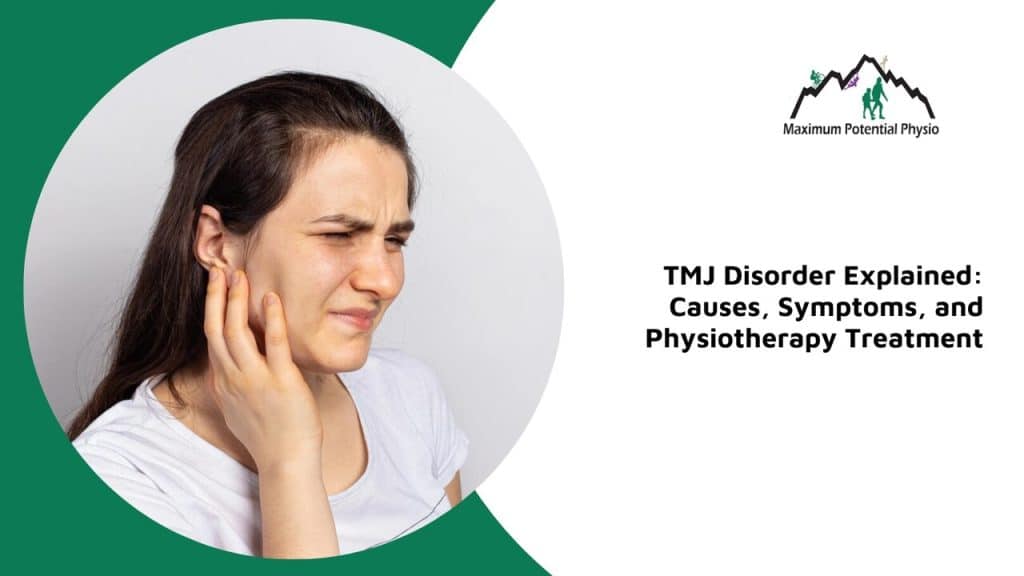TMJ Disorder Explained: Causes, Symptoms, and Physiotherapy Treatment

The temporomandibular joint (TMJ) is essential for speaking, chewing, and everyday jaw movements. However, when this joint becomes irritated or misaligned, it can lead to TMJ disorder (TMD), a condition that causes pain, stiffness, and restricted jaw movement. Left untreated, TMJ dysfunction can contribute to chronic headaches, neck pain, and even difficulty eating or speaking comfortably. In this blog, we’ll explore what TMJ disorder is, how physiotherapy for TMJ can help ease jaw pain, the techniques used in treatment, and what to expect during recovery. If you’re experiencing jaw pain, clicking, or tension, understanding the role of physiotherapy can help you take proactive steps toward relief.
Understanding TMJ Disorders
TMJ disorder (TMD) affects the temporomandibular joint (TMJ), which connects the lower jaw to the skull and enables essential movements like chewing and speaking. When this joint becomes irritated, misaligned, or strained, it can cause pain, stiffness, and restricted movement.
Several factors contribute to TMJ disorder. Jaw misalignment from poor bite mechanics or previous injuries can interfere with joint function. Chronic teeth grinding or clenching, often linked to stress, places excessive strain on the TMJ and surrounding muscles. Trauma, such as a blow to the jaw or whiplash, can also lead to dysfunction. Arthritis, particularly osteoarthritis or rheumatoid arthritis, may cause cartilage deterioration, limiting movement and increasing discomfort. Stress-related muscle tension in the jaw and face can further exacerbate symptoms.
Because the TMJ is essential for daily function, TMD can make simple tasks like eating and speaking painful. Without treatment, symptoms may worsen. Physiotherapy can help alleviate discomfort, restore mobility, and prevent long-term complications.
The Role of Physiotherapy in Treating TMJ Disorders
Physiotherapy is a highly effective treatment for TMJ disorders, focusing on reducing pain, improving jaw mobility, and restoring normal function. A comprehensive physiotherapy program for TMD may include:
- Pain Management: Physiotherapists use manual therapy, relaxation techniques, and therapeutic modalities to reduce discomfort.
- Jaw Mobility Exercises: Gentle stretching and strengthening exercises improve joint function and reduce stiffness.
- Muscle Relaxation Techniques: Many TMJ issues stem from tight or overactive jaw muscles, and physiotherapy helps release tension.
- Postural Corrections: Since poor posture (especially forward head posture) can contribute to TMJ dysfunction, physiotherapy includes strategies to improve alignment.
- Education on Habits and Lifestyle Modifications: Clients learn techniques to prevent further strain on the TMJ, such as jaw relaxation methods and proper chewing habits.
Physiotherapy provides a non-invasive and drug-free approach to TMJ treatment, addressing both the symptoms and underlying causes of jaw dysfunction.
Techniques Physiotherapists Use for TMJ Treatment
Physiotherapy for TMJ disorders involves a combination of hands-on therapy, targeted exercises, and pain management techniques. Some of the most effective treatment methods include:
- Manual Therapy and Joint Mobilization: Hands-on techniques improve TMJ alignment, reduce muscle tension, and restore mobility.
- Myofascial Release: This technique relieves tightness in the jaw, neck, and facial muscles, helping reduce pain and discomfort.
- Postural Training and Ergonomics: Since neck and jaw alignment play a role in TMJ function, physiotherapists focus on correcting forward head posture and muscle imbalances.
- Dry Needling: In some cases, dry needling may be used to relieve tension and promote blood flow to the jaw muscles.
Each treatment plan is tailored to the individual, depending on the severity of symptoms and underlying causes.
How Long Does It Take to See Results From TMJ Physiotherapy?
Recovery time for TMJ disorder depends on severity, treatment consistency, and underlying factors. Mild cases often improve within two to four weeks with physiotherapy and lifestyle adjustments. Symptoms like mild jaw tension or clicking typically respond well to early intervention.
For moderate TMJ issues, where stiffness or misalignment affects daily life, six to eight weeks of physiotherapy may be needed. A structured rehabilitation plan, including jaw mobility exercises and postural corrections, helps restore function and reduce discomfort.
Chronic or severe TMJ disorders, especially those linked to arthritis or long-term bruxism, may require several months of treatment. These cases focus on pain management, muscle relaxation, and gradual mobility improvements. Sticking to at-home exercises and stress management techniques can accelerate recovery and prevent recurrences.
At-Home Exercises to Relieve TMJ Pain
In addition to professional treatment, simple at-home exercises can help reduce jaw tension and improve mobility. Here are a few effective exercises:
- Controlled Jaw Opening: Place the tongue on the roof of your mouth, slowly open your jaw to a comfortable position, then close it. Repeat 5–10 times to promote controlled movement.
- Chin Tucks: While keeping your spine straight, gently tuck your chin inwards (as if making a double chin). Hold for 5 seconds and repeat 10 times to improve neck and jaw alignment.
- Side-to-Side Jaw Movements: Keeping the mouth slightly open, move the lower jaw side to side in a controlled manner. Repeat 10 times to improve flexibility.
- Resisted Jaw Opening and Closing: Place light pressure under your chin with your thumb while opening your mouth. Hold for 5 seconds, then close your mouth while applying resistance on top of the chin. Repeat 5–10 times to strengthen jaw muscles.
- Massaging the Jaw Muscles: Gently massage the jaw, temples, and neck to reduce muscle tension and improve circulation.
These exercises should be performed gently and without pain. If discomfort increases, consult your physiotherapist for guidance.
Lifestyle Changes to Support TMJ Recovery
In addition to physiotherapy, lifestyle modifications play a crucial role in managing TMJ disorders and preventing symptom flare-ups. Making small adjustments to daily habits can reduce stress on the jaw, minimize tension, and support long-term recovery. Some key lifestyle changes include:
- Avoid Excessive Jaw Strain: Limit chewing hard or chewy foods like gum, steak, or tough bread, which can put unnecessary stress on the TMJ. Opt for softer foods when experiencing a flare-up.
- Practice Jaw Relaxation Techniques: If you clench your jaw due to stress, try mindfulness, meditation, or breathing exercises to keep your muscles relaxed.
- Use Heat or Cold Therapy: Applying a warm compress helps relax tense jaw muscles, while an ice pack can reduce inflammation and numb pain.
- Correct Your Sleeping Position: Sleeping on your back with a supportive pillow helps maintain proper neck and jaw alignment, reducing tension on the TMJ.
- Improve Posture: Forward head posture and slouched shoulders can contribute to jaw strain. Keeping your spine aligned while sitting and standing can alleviate unnecessary pressure on the TMJ.
- Limit Jaw Movements That Exacerbate Pain: Avoid habits like yawning widely, biting your nails, or resting your chin on your hand, as these can worsen symptoms.
Implementing these small but effective lifestyle changes can complement physiotherapy treatment and help prevent recurring TMJ discomfort.
What to Expect During Your First TMJ Physiotherapy Session
If you’re seeking physiotherapy for TMJ disorder for the first time, it’s normal to wonder what the session will involve. A typical first visit includes:
- Comprehensive Assessment: Your physiotherapist will ask about your symptoms, medical history, daily habits, and potential contributing factors such as teeth grinding, stress, or poor posture.
- Jaw and Neck Examination: This involves evaluating jaw movement, muscle tightness, joint mobility, and posture to identify the underlying causes of dysfunction.
- Pain and Tension Evaluation: The physiotherapist will gently palpate jaw, face, and neck muscles to pinpoint areas of tightness or discomfort.
- Initial Treatment: Depending on your condition, your physiotherapist may begin with manual therapy, jaw mobility exercises, or relaxation techniques to relieve tension.
- Education and Home Care Plan: You'll receive guidance on lifestyle modifications, posture corrections, and at-home exercises to continue progress between sessions.
Your first physiotherapy session is focused on understanding your condition and creating a personalized treatment plan to restore TMJ function and alleviate pain.
Risks of Leaving TMJ Disorders Untreated
Ignoring TMJ disorder can lead to worsening pain, reduced mobility, and long-term complications. Chronic jaw stiffness can make chewing and speaking increasingly difficult. Ongoing strain on the joint may contribute to cartilage breakdown and arthritis, further limiting movement.
Untreated TMJ dysfunction often causes frequent headaches or migraines due to muscle tension in the jaw, temples, and neck. Discomfort can spread to the neck and shoulders, leading to postural imbalances. Some individuals experience jaw clicking or locking, making it difficult to open or close their mouth fully.
Teeth grinding and clenching, common with TMJ dysfunction, can lead to excessive tooth wear, sensitivity, and fractures. Over time, this may require orthodontic or dental intervention. Seeking physiotherapy early can prevent these issues, restore function, and improve long-term comfort.
Don’t Let Jaw Pain Ruin Your Day
TMJ disorders can disrupt daily life, making simple activities like chewing, talking, and even yawning uncomfortable. The good news is that physiotherapy offers a safe, effective, and non-invasive approach to relieving TMJ pain, improving mobility, and preventing further complications. Through targeted treatment techniques and personalized care, physiotherapy can help restore comfort and function.
At Maximum Potential Physiotherapy in Calgary NW, our experienced team is committed to helping you overcome TMJ pain with evidence-based treatment plans tailored to your needs. Don’t let jaw discomfort hold you back—book an appointment today and take the first step toward lasting relief.

